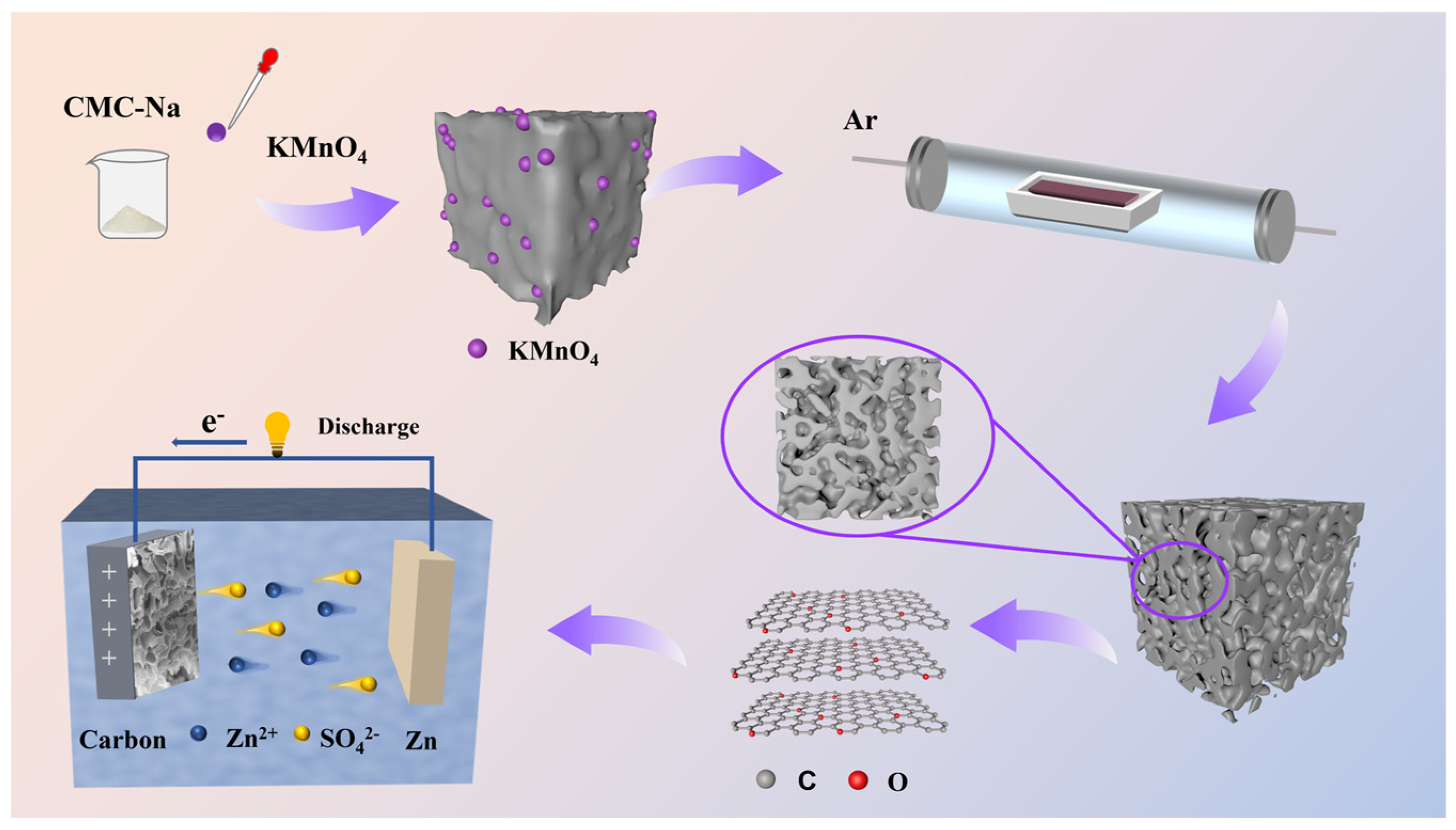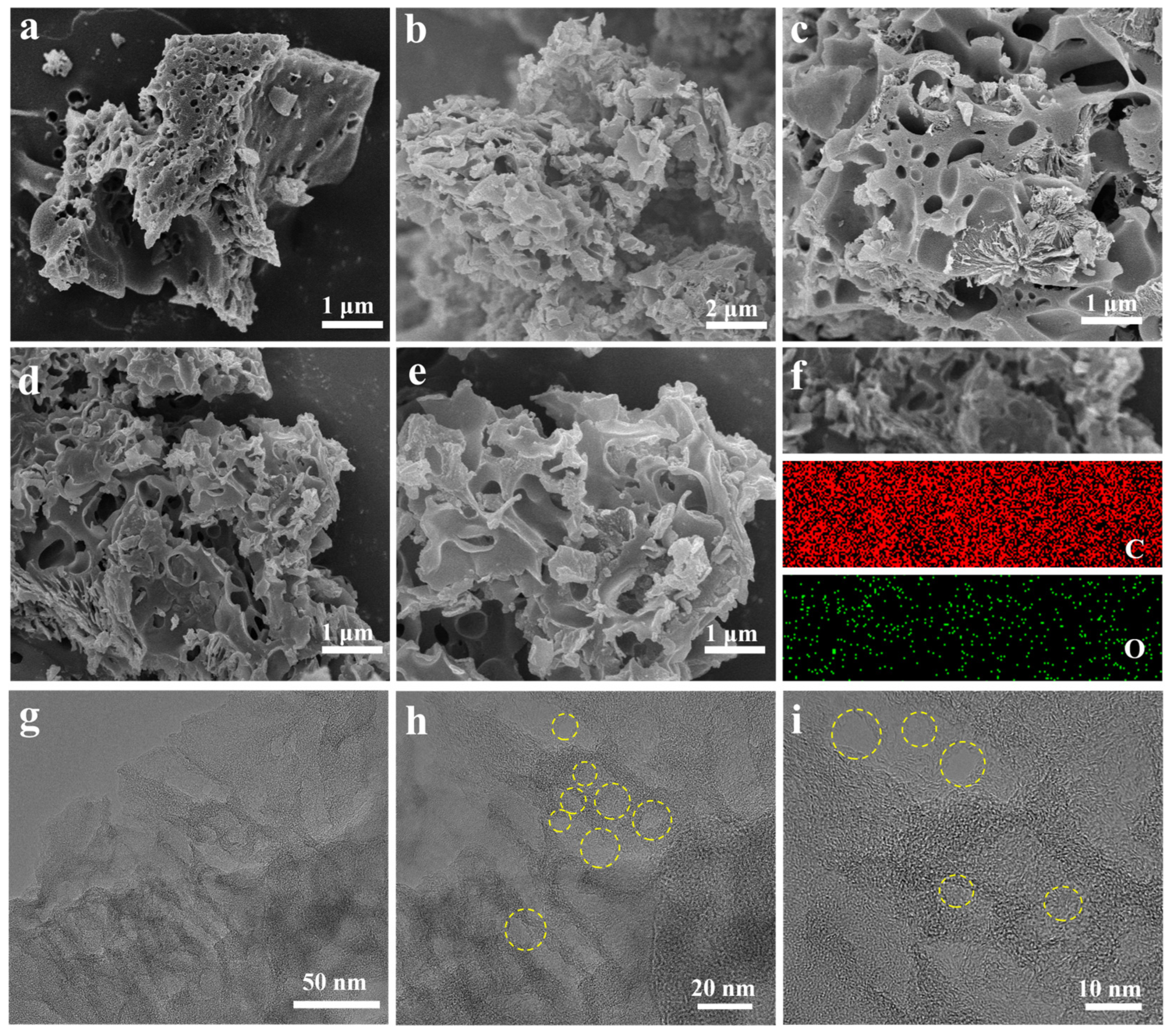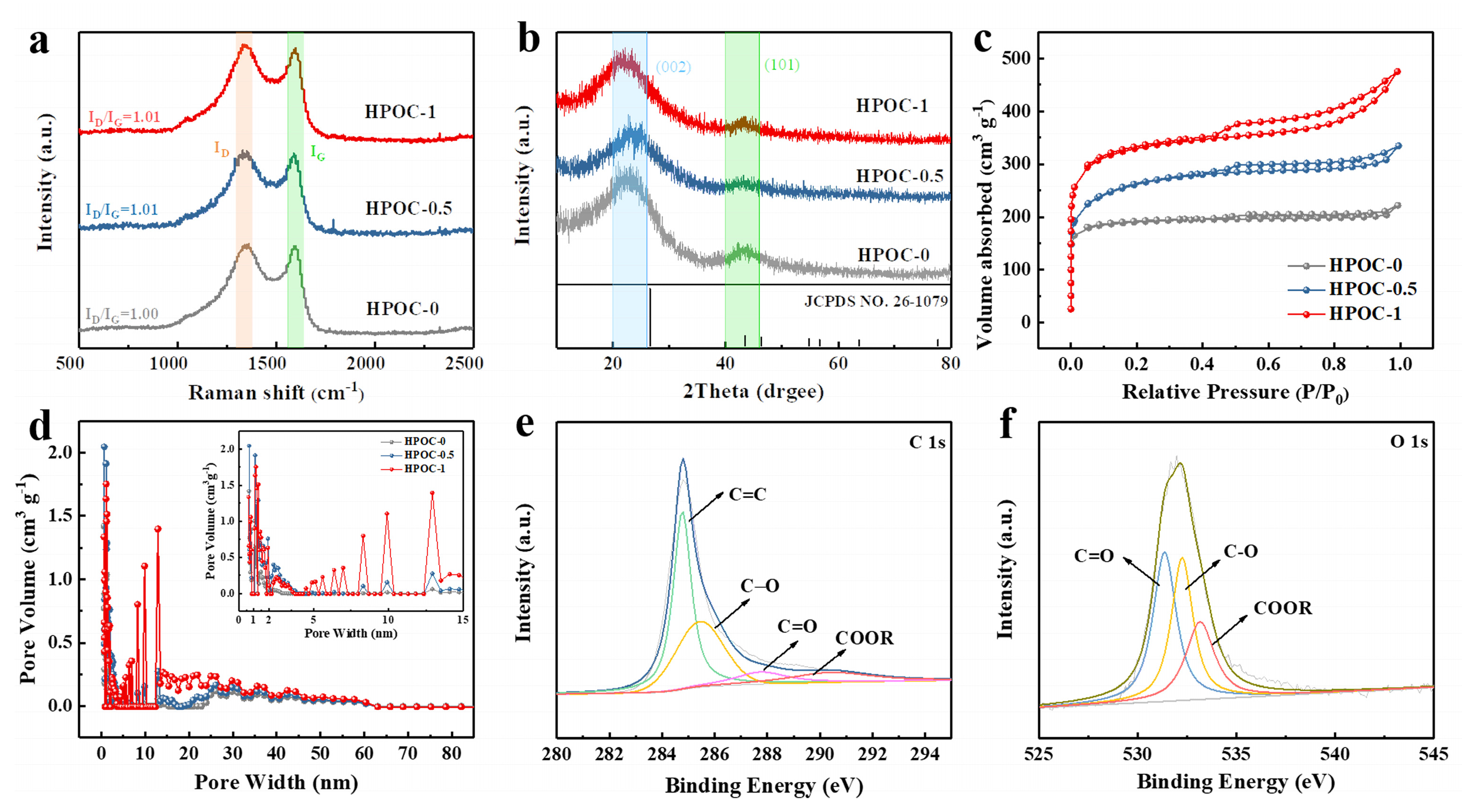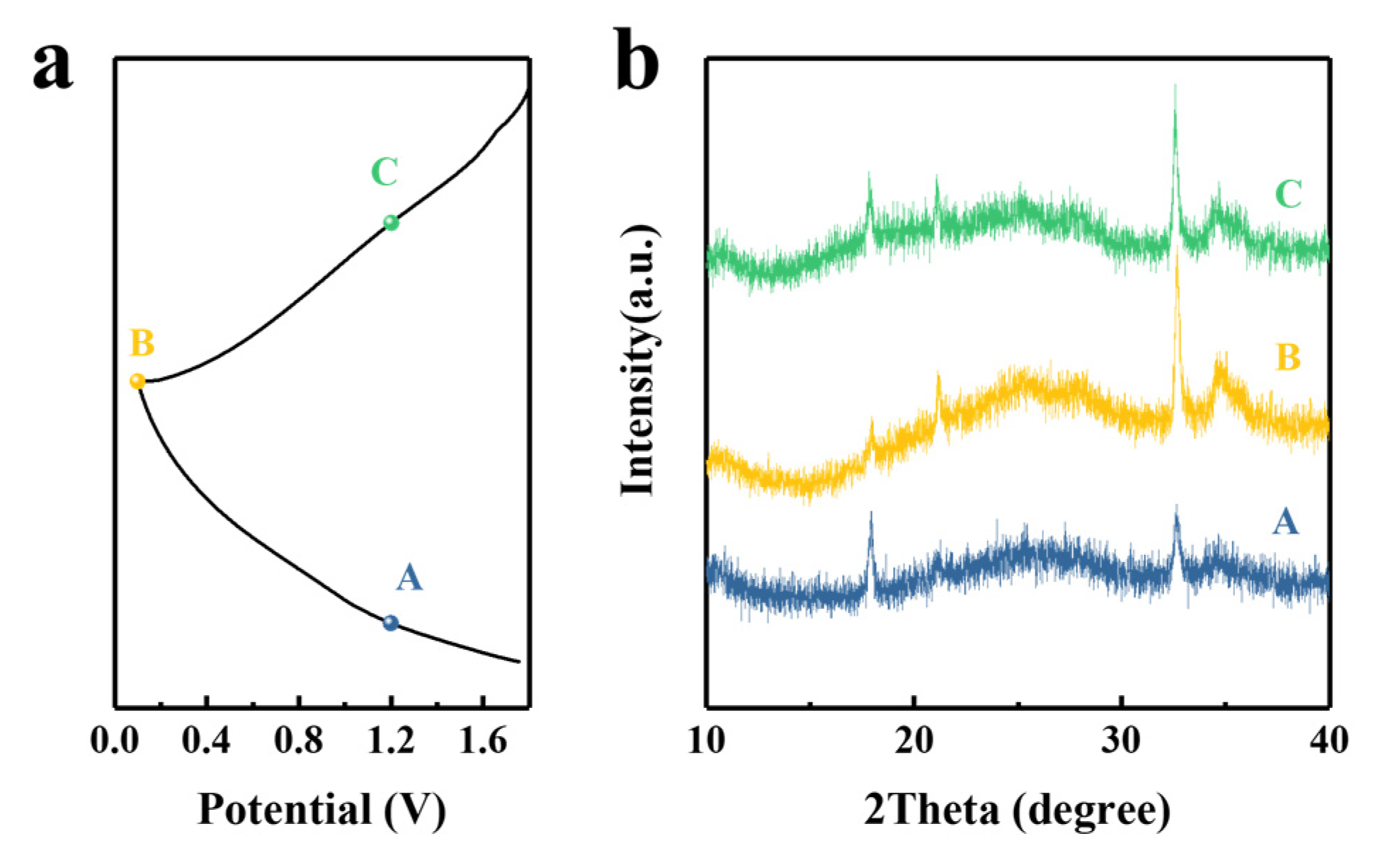Boosting the Capacitance of Aqueous Zinc-Ion Hybrid Capacitors by Engineering Hierarchical Porous Carbon Architecture
Abstract
:1. Introduction
2. Materials and Methods
2.1. Chemicals
2.2. Preparation of Hierarchical Porous Oxygen-Containing Carbon (HPOC)
2.3. Preparation of Flexible Gel Electrolyte for Solid-State-Battery
2.4. Structural Characterization
2.5. Electrochemical Measurements
3. Results
3.1. Material Characteristics
3.2. Electrochemical Properties of Aqueous HPOC//Zn System
4. Conclusions
Supplementary Materials
Author Contributions
Funding
Data Availability Statement
Conflicts of Interest
References
- Chen, Z.; Hsu, P.; Lopez, J. Fast and reversible thermoresponsive polymer switching materials for safer batteries. Nat. Energy 2016, 1, 15009. [Google Scholar] [CrossRef]
- Li, Z.; An, Y.; Dong, S. Progress on zinc ion hybrid supercapacitors: Insights and challenges. Energy Storage Mater. 2020, 31, 252–266. [Google Scholar] [CrossRef]
- Liu, Q.; Zhang, H.; Xie, J. Recent progress and challenges of carbon materials for zn-ion hybrid supercapacitors. Carbon Energy 2020, 2, 521–539. [Google Scholar] [CrossRef]
- Su, L.; Gong, L.; Wang, X. Improved low-temperature performance of novel asymmetric supercapacitor with capacitor/battery-capacitor construction. Int. J. Energy Res. 2016, 40, 763–769. [Google Scholar] [CrossRef]
- Dai, Y.; Liu, C.; Bai, Y. Framework materials for supercapacitors. Nanotechnol. Rev. 2022, 11, 1005–1046. [Google Scholar] [CrossRef]
- Yin, J.; Zhang, W.; Alhebshi, N.A. Synthesis strategies of porous carbon for supercapacitor applications. Small Methods 2020, 4, 1900853. [Google Scholar] [CrossRef]
- Tian, Y.; Zeng, G.; Rutt, A. Promises and challenges of next-generation “beyond li-ion” batteries for electric vehicles and grid decarbonization. Chem. Rev. 2021, 121, 1623–1669. [Google Scholar] [CrossRef] [PubMed]
- Wang, H.; Zhu, C.; Chao, D. Nonaqueous hybrid lithium-ion and sodium-ion capacitors. Adv. Mater. 2017, 29, 1702093. [Google Scholar] [CrossRef]
- Zhang, X.; Chen, C.; Gao, S. Graphene as regulating zinc deposition layer for long-life zinc ion hybrid supercapacitors. J. Energy Storage 2021, 42, 103037. [Google Scholar] [CrossRef]
- Zhang, L.; Wu, D.; Wang, G. An aqueous zinc-ion hybrid super-capacitor for achieving ultrahigh-volumetric energy density. Chin. Chem. Lett. 2021, 32, 926–931. [Google Scholar] [CrossRef]
- Li, Z.; Chen, D.; An, Y. Flexible and anti-freezing quasi-solid-state zinc ion hybrid supercapacitors based on pencil shavings derived porous carbon. Energy Storage Mater. 2020, 28, 307–314. [Google Scholar] [CrossRef]
- Wang, T.; Li, S.; Weng, X.; Gao, L.; Yan, Y.; Zhang, N.; Qu, X.; Jiao, L.; Liu, Y. Ultrafast 3d hybrid-ion transport in porous cathodes for superior-rate rechargeable aqueous zinc batteries. Adv. Energy Mater. 2023, 13, 2204358. [Google Scholar] [CrossRef]
- Sun, W.; Wang, F.; Hou, S. Zn/MnO2 battery chemistry with H+ and Zn2+ coinsertion. J. Am. Chem. Soc. 2017, 139, 9775–9778. [Google Scholar] [CrossRef] [PubMed]
- Luo, X.; Chen, Y.; Mo, Y. A review of charge storage in porous carbon-based supercapacitors. New Carbon Mater. 2021, 36, 49–68. [Google Scholar] [CrossRef]
- Ma, Q.; Xi, H.; Cui, F. Self-templating synthesis of hierarchical porous carbon with multi-heteroatom co-doping from tea waste for high-performance supercapacitor. J. Energy Storage 2022, 45, 103509. [Google Scholar] [CrossRef]
- Dubal, D.P.; Ayyad, O.; Ruiz, V. Hybrid energy storage: The merging of battery and supercapacitor chemistries. Chem. Soc. Rev. 2015, 44, 1179–1777. [Google Scholar] [CrossRef] [PubMed]
- Jha, S.; Akula, B.; Boddu, P. Roles of molecular structure of carbon-based materials in energy storage. Mater. Today Sustain. 2023, 22, 100375. [Google Scholar] [CrossRef]
- Zhou, Z.; Zhou, X.; Zhang, M. In situ two-step activation strategy boosting hierarchical porous carbon cathode for an aqueous zn-based hybrid energy storage device with high capacity and ultra-long cycling life. Small 2020, 16, 2003174. [Google Scholar] [CrossRef]
- Zou, Z.; Luo, X.; Wang, L. Highly mesoporous carbons derived from corn silks as high performance electrode materials of supercapacitors and zinc ion capacitors. J. Energy Storage 2021, 44, 103385. [Google Scholar] [CrossRef]
- Zhang, L.; Zhang, F.; Yang, X. Porous 3D graphene-based bulk materials with exceptional high surface area and excellent conductivity for supercapacitors. Sci. Rep. 2013, 3, 1408. [Google Scholar] [CrossRef]
- Lu, Y.; Zhang, S.; Yin, J. Mesoporous activated carbon materials with ultrahigh mesopore volume and effective specific surface area for high performance supercapacitors. Carbon 2017, 124, 64–71. [Google Scholar] [CrossRef]
- Liu, J.; Wang, J.; Xu, C. Advanced energy storage devices: Basic principles, analytical methods, and rational materials design. Adv. Sci. 2018, 5, 1700322. [Google Scholar] [CrossRef] [PubMed]
- Lu, Y.; Zhang, F.; Zhang, T. Synthesis and supercapacitor performance studies of n-doped graphene materials using o-phenylenediamine as the double-n precursor. Carbon 2013, 63, 508–516. [Google Scholar] [CrossRef]
- Ghosh, S.; Barg, S.; Jeong, S.M. Heteroatom-doped and oxygen-functionalized nanocarbons for high-performance supercapacitors. Adv. Energy Mater. 2020, 10, 2001239. [Google Scholar] [CrossRef]
- Su, H.; Lan, C.; Wang, Z. Controllable preparation of eucommia wood-derived mesoporous activated carbon as electrode materials for supercapacitors. Polymers 2023, 15, 663. [Google Scholar] [CrossRef] [PubMed]
- Li, M.; Wang, Y.; Liu, Y. Preparation of active carbon through one-step naoh activation of coconut shell biomass for phenolic wastewater treatment. Res. Chem. Intermed. 2022, 48, 1665–1684. [Google Scholar] [CrossRef]
- Zhu, X.; Yu, S.; Xu, K. Sustainable activated carbons from dead ginkgo leaves for supercapacitor electrode active materials. Chem. Eng. Sci. 2018, 181, 36–45. [Google Scholar] [CrossRef]
- Becerra, M.E.; Arias, N.P.; Giraldo, O.H. Soot combustion manganese catalysts prepared by thermal decomposition of kmno4. Appl. Catal. B Environ. 2011, 102, 260–266. [Google Scholar] [CrossRef]
- Lv, S.; Li, C.; Mi, J.; Meng, H. A functional activated carbon for efficient adsorption of phenol derived from pyrolysis of rice husk, koh-activation and edta-4na-modification. Appl. Surf. Sci. 2020, 510, 145425. [Google Scholar] [CrossRef]
- Zhang, B.; Yang, D.; Qiu, X. Influences of aggregation behavior of lignin on the microstructure and adsorptive properties of lignin-derived porous carbons by potassium compound activation. J. Ind. Eng. Chem. 2020, 82, 220–227. [Google Scholar] [CrossRef]
- Rahman, M.S.; Hasan, M.S.; Nitai, A.S. Recent developments of carboxymethyl cellulose. Polymers 2021, 13, 1345. [Google Scholar] [CrossRef] [PubMed]
- Quan, H.; Tao, W.; Wang, Y. Enhanced supercapacitor performance of camellia oleifera shell derived hierarchical porous carbon by carbon quantum dots. J. Energy Storage 2022, 55, 105573. [Google Scholar] [CrossRef]
- Bi, H.; He, X.; Zhang, H. N, p co-doped hierarchical porous carbon from rapeseed cake with enhanced supercapacitance. Renew. Energy 2021, 170, 188–196. [Google Scholar] [CrossRef]
- Yuan, M.; Gao, M.; Shi, Q. Understanding the characteristics of water adsorption in zeolitic imidazolate framework-derived porous carbon materials. Chem. Eng. J. 2020, 379, 122412. [Google Scholar] [CrossRef]
- Liu, X.; Zhu, H.; Gong, L. New insights into hierarchical pore size and level of concentration in efficient removal of toluene vapor by activated carbon. Sci. Total Environ. 2022, 853, 158719. [Google Scholar] [CrossRef]
- Ma, T.; Liao, L.; Zhang, X. Hierarchical pores from microscale to macroscale boost ultrahigh lithium intercalation pseudocapacitance of biomass carbon. J. Energy Storage 2021, 33, 102068. [Google Scholar] [CrossRef]
- Bai, Q.; Xiong, Q.; Li, C. Hierarchical porous carbons from a sodium alginate/bacterial cellulose composite for high-performance supercapacitor electrodes. Appl. Surf. Sci. 2018, 455, 795–807. [Google Scholar] [CrossRef]
- Wang, H.; Chen, X.; Zhang, J. Unveiling the cooperative roles of pyrrolic-n and carboxyl groups in biomass-derived hierarchical porous carbon nanosheets for high energy-power zn-ion hybrid supercapacitors. Appl. Surf. Sci. 2022, 598, 153819. [Google Scholar] [CrossRef]
- Huang, L.; Xiang, Y.; Luo, M. Hierarchically porous carbon with heteroatom doping for the application of Zn-ion capacitors. Carbon 2021, 185, 1–8. [Google Scholar] [CrossRef]
- An, G. Ultrafast long-life zinc-ion hybrid supercapacitors constructed from mesoporous structured activated carbon. Appl. Surf. Sci. 2020, 530, 147220. [Google Scholar] [CrossRef]
- Zhang, X.; Zhang, Y.; Zhang, H. Zinc-ion hybrid capacitor with high energy density constructed by bamboo shavings derived spongy-like porous carbon. ChemistrySelect 2021, 6, 6937–6943. [Google Scholar] [CrossRef]
- Wang, D.; Pan, Z.; Chen, G. Glycerol derived mesopore-enriched hierarchically carbon nanosheets as the cathode for ultrafast zinc ion hybrid supercapacitor applications. Electrochim. Acta 2021, 379, 138170. [Google Scholar] [CrossRef]
- Han, L.; Zhang, X.; Li, J. Enhanced energy storage of aqueous zinc-carbon hybrid supercapacitors via employing alkaline medium and b, n dual doped carbon cathode. J. Colloid Interface Sci. 2021, 599, 556–565. [Google Scholar] [CrossRef] [PubMed]
- Chen, G.; Hu, Z.; Pan, Z. Design of honeycomb-like hierarchically porous carbons with engineered mesoporosity for aqueous zinc-ion hybrid supercapacitors applications. J. Energy Storage 2021, 38, 102534. [Google Scholar] [CrossRef]
- Ding, B.; Guo, D.; Wang, Y. Functionalized graphene nanosheets decorated on carbon nanotubes networks for high performance supercapacitors. J. Power Sources 2018, 398, 113–119. [Google Scholar] [CrossRef]
- Zhang, J.; Zhang, X.; Zhou, Y. Nitrogen-doped hierarchical porous carbon nanowhisker ensembles on carbon nanofiber for high-performance supercapacitors. ACS Sustain. Chem. Eng. 2014, 2, 1525–1533. [Google Scholar] [CrossRef]
- Zhang, Q.; Yan, B.; Feng, L.; Zheng, J.; You, B.; Chen, J.; Zhao, X.; Zhang, C.; Jiang, S.; He, S. Progress in the use of organic potassium salts for the synthesis of porous carbon nanomaterials: Microstructure engineering for advanced supercapacitors. Nanoscale 2022, 14, 8216–8244. [Google Scholar] [CrossRef] [PubMed]
- Dong, Y.; Li, Y.; Shi, H.; Qin, J.; Zheng, S.; He, R.; Wu, Z.-S. Graphene encapsulated iron nitrides confined in 3d carbon nanosheet frameworks for high-rate lithium ion batteries. Carbon 2020, 159, 213–220. [Google Scholar] [CrossRef]
- Xu, H.; He, W.; Li, Z. Revisiting charge storage mechanism of reduced graphene oxide in zinc ion hybrid capacitor beyond the contribution of oxygen-containing groups. Adv. Funct. Mater. 2022, 32, 2111131. [Google Scholar] [CrossRef]
- Deng, W.; Li, Y.; Xu, D.; Zhou, W.; Xiang, K.-X.; Chen, H. Three-dimensional hierarchically porous nitrogen-doped carbon from water hyacinth as selenium host for high-performance lithium–selenium batteries. Rare Met. 2022, 41, 3432–3445. [Google Scholar] [CrossRef]
- Li, Y.; Yang, W.; Yang, W. Towards high-energy and anti-self-discharge Zn-ion hybrid supercapacitors with new understanding of the electrochemistry. Nano-Micro Lett. 2021, 13, 95. [Google Scholar] [CrossRef] [PubMed]
- Yan, B.; Zheng, J.; Feng, L.; Zhang, Q.; Zhang, C.; Ding, Y.; Han, J.; Jiang, S.; He, S. Pore engineering: Structure-capacitance correlations for biomass-derived porous carbon materials. Mater Des. 2023, 229, 111904. [Google Scholar] [CrossRef]
- Shang, P.; Liu, M.; Mei, Y. Urea-mediated monoliths made of nitrogen-enriched mesoporous carbon nanosheets for high-performance aqueous zinc ion hybrid capacitors. Small 2022, 18, 2108057. [Google Scholar] [CrossRef] [PubMed]
- Liu, C.; Wu, J.C.; Zhou, H. Great enhancement of carbon energy storage through narrow pores and hydrogen-containing functional groups for aqueous zn-ion hybrid supercapacitor. Molecules 2019, 24, 2589. [Google Scholar] [CrossRef]
- Zhao, Y.; Hao, H.; Song, T. High energy-power density zn-ion hybrid supercapacitors with n/p co-doped graphene cathode. J. Power Sources 2022, 521, 230941. [Google Scholar] [CrossRef]
- Yu, J.; Wang, L.; Peng, J. O-doped porous carbon derived from biomass waste for high-performance zinc-ion hybrid supercapacitors. Ionics 2021, 27, 4495–4505. [Google Scholar] [CrossRef]
- Wang, H.; Wang, M.; Tang, Y. A novel zinc-ion hybrid supercapacitor for long-life and low-cost energy storage applications. Energy Storage Mater. 2018, 13, 1–7. [Google Scholar] [CrossRef]
- Lou, G.; Pei, G.; Wu, Y.; Lu, Y.; Wu, Y.; Zhu, X.; Pang, Y.; Shen, Z.; Wu, Q.; Fu, S.; et al. Combustion conversion of wood to N, O co-doped 2d carbon nanosheets for zinc-ion hybrid supercapacitors. Chem. Eng. J. 2021, 413, 127502. [Google Scholar] [CrossRef]
- Yan, B.; Zheng, J.; Feng, L.; Zhang, Q.; Han, J.; Hou, H.; Zhang, C.; Ding, Y.; Jiang, S.; He, S. Green H2O2 activation of electrospun polyimide-based carbon nanofibers towards high-performance free-standing electrodes for supercapacitors. Diam. Relat. Mater. 2022, 130, 109465. [Google Scholar] [CrossRef]
- Zheng, J.; Yan, B.; Feng, L.; Zhang, Q.; Zhang, C.; Yang, W.; Han, J.; Jiang, S.; He, S. Potassium citrate assisted synthesis of hierarchical porous carbon materials for high performance supercapacitors. Diam. Relat. Mater. 2022, 128, 109247. [Google Scholar] [CrossRef]
- Shi, X.; Xie, J.; Yang, F. Compacting electric double layer enables carbon electrode with ultrahigh Zn ion storage capability. Angew. Chem. Int. Ed. 2022, 61, e202214773. [Google Scholar] [CrossRef] [PubMed]
- Yu, P.; Zeng, Y.; Zeng, Y. Achieving high-energy-density and ultra-stable zinc-ion hybrid supercapacitors by engineering hierarchical porous carbon architecture. Electrochim. Acta 2019, 327, 134999. [Google Scholar] [CrossRef]
- Chen, M.; Chen, J.; Zhou, W. High-performance flexible and self-healable quasisolid-state zinc-ion hybrid supercapacitor based on borax-crosslinked polyvinyl alcohol/nanocellulose hydrogel electrolyte. J. Mater. Chem. A 2019, 7, 26524. [Google Scholar] [CrossRef]
- Shi, X.; Zhang, H.; Zeng, S.; Liu, X.; Lu, X. Pyrrolic-dominated nitrogen redox enhances reaction kinetics of pitch-derived carbon materials in aqueous zinc ion hybrid supercapacitors. ACS Mater. Lett. 2021, 3, 1291–1299. [Google Scholar] [CrossRef]
- Liu, Z.; Li, G.; Cui, T. A battery-supercapacitor hybrid device composed of metallic zinc, a biodegradable ionic liquid electrolyte and graphite. J. Solid State Electrochem. 2018, 22, 91–101. [Google Scholar] [CrossRef]
- Zheng, Y.; Zhao, W.; Jia, D. Porous carbon prepared via combustion and acid treatment as flexible zinc-ion capacitor electrode material. Chem. Eng. J. 2020, 387, 124161. [Google Scholar] [CrossRef]
- Liu, H.; Chen, H.; Shi, K. Lignin-derived porous carbon for zinc-ion hybrid capacitor. Ind. Crops Prod. 2022, 187, 115519. [Google Scholar] [CrossRef]
- Hui, J.; Yan, C.; Shi, Y. A biomass cathode derived from hyacinth bean for aqueous zinc-ion capacitors. Ionics 2022, 28, 1495–1499. [Google Scholar] [CrossRef]
- Liu, L.; Lu, Y.; Qiu, D. Sodium alginate-derived porous carbon: Self-template carbonization mechanism and application in capacitive energy storage. J. Colloid Interface Sci. 2022, 620, 284–292. [Google Scholar] [CrossRef]
- Liu, P.; Gao, Y.; Tan, Y.; Liu, W.; Huang, Y.; Yan, J.; Liu, K. Rational design of nitrogen doped hierarchical porous carbon for optimized zinc-ion hybrid supercapacitors. Nano Res. 2019, 12, 2835–2841. [Google Scholar] [CrossRef]







Disclaimer/Publisher’s Note: The statements, opinions and data contained in all publications are solely those of the individual author(s) and contributor(s) and not of MDPI and/or the editor(s). MDPI and/or the editor(s) disclaim responsibility for any injury to people or property resulting from any ideas, methods, instructions or products referred to in the content. |
© 2023 by the authors. Licensee MDPI, Basel, Switzerland. This article is an open access article distributed under the terms and conditions of the Creative Commons Attribution (CC BY) license (https://creativecommons.org/licenses/by/4.0/).
Share and Cite
Li, Y.; Zhang, X.; Lu, T.; Zhang, Y.; Li, X.; Yu, D.; Zhao, G. Boosting the Capacitance of Aqueous Zinc-Ion Hybrid Capacitors by Engineering Hierarchical Porous Carbon Architecture. Batteries 2023, 9, 429. https://doi.org/10.3390/batteries9080429
Li Y, Zhang X, Lu T, Zhang Y, Li X, Yu D, Zhao G. Boosting the Capacitance of Aqueous Zinc-Ion Hybrid Capacitors by Engineering Hierarchical Porous Carbon Architecture. Batteries. 2023; 9(8):429. https://doi.org/10.3390/batteries9080429
Chicago/Turabian StyleLi, Yanzhen, Xin Zhang, Tong Lu, Ying Zhang, Xue Li, Dengfeng Yu, and Gongyuan Zhao. 2023. "Boosting the Capacitance of Aqueous Zinc-Ion Hybrid Capacitors by Engineering Hierarchical Porous Carbon Architecture" Batteries 9, no. 8: 429. https://doi.org/10.3390/batteries9080429



